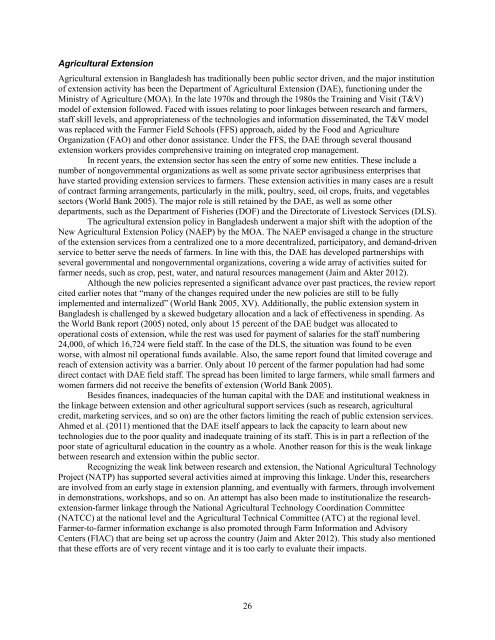Review of Input and Output Policies for Cereal Production in ...
Review of Input and Output Policies for Cereal Production in ...
Review of Input and Output Policies for Cereal Production in ...
Create successful ePaper yourself
Turn your PDF publications into a flip-book with our unique Google optimized e-Paper software.
Agricultural Extension<br />
Agricultural extension <strong>in</strong> Bangladesh has traditionally been public sector driven, <strong>and</strong> the major <strong>in</strong>stitution<br />
<strong>of</strong> extension activity has been the Department <strong>of</strong> Agricultural Extension (DAE), function<strong>in</strong>g under the<br />
M<strong>in</strong>istry <strong>of</strong> Agriculture (MOA). In the late 1970s <strong>and</strong> through the 1980s the Tra<strong>in</strong><strong>in</strong>g <strong>and</strong> Visit (T&V)<br />
model <strong>of</strong> extension followed. Faced with issues relat<strong>in</strong>g to poor l<strong>in</strong>kages between research <strong>and</strong> farmers,<br />
staff skill levels, <strong>and</strong> appropriateness <strong>of</strong> the technologies <strong>and</strong> <strong>in</strong><strong>for</strong>mation dissem<strong>in</strong>ated, the T&V model<br />
was replaced with the Farmer Field Schools (FFS) approach, aided by the Food <strong>and</strong> Agriculture<br />
Organization (FAO) <strong>and</strong> other donor assistance. Under the FFS, the DAE through several thous<strong>and</strong><br />
extension workers provides comprehensive tra<strong>in</strong><strong>in</strong>g on <strong>in</strong>tegrated crop management.<br />
In recent years, the extension sector has seen the entry <strong>of</strong> some new entities. These <strong>in</strong>clude a<br />
number <strong>of</strong> nongovernmental organizations as well as some private sector agribus<strong>in</strong>ess enterprises that<br />
have started provid<strong>in</strong>g extension services to farmers. These extension activities <strong>in</strong> many cases are a result<br />
<strong>of</strong> contract farm<strong>in</strong>g arrangements, particularly <strong>in</strong> the milk, poultry, seed, oil crops, fruits, <strong>and</strong> vegetables<br />
sectors (World Bank 2005). The major role is still reta<strong>in</strong>ed by the DAE, as well as some other<br />
departments, such as the Department <strong>of</strong> Fisheries (DOF) <strong>and</strong> the Directorate <strong>of</strong> Livestock Services (DLS).<br />
The agricultural extension policy <strong>in</strong> Bangladesh underwent a major shift with the adoption <strong>of</strong> the<br />
New Agricultural Extension Policy (NAEP) by the MOA. The NAEP envisaged a change <strong>in</strong> the structure<br />
<strong>of</strong> the extension services from a centralized one to a more decentralized, participatory, <strong>and</strong> dem<strong>and</strong>-driven<br />
service to better serve the needs <strong>of</strong> farmers. In l<strong>in</strong>e with this, the DAE has developed partnerships with<br />
several governmental <strong>and</strong> nongovernmental organizations, cover<strong>in</strong>g a wide array <strong>of</strong> activities suited <strong>for</strong><br />
farmer needs, such as crop, pest, water, <strong>and</strong> natural resources management (Jaim <strong>and</strong> Akter 2012).<br />
Although the new policies represented a significant advance over past practices, the review report<br />
cited earlier notes that “many <strong>of</strong> the changes required under the new policies are still to be fully<br />
implemented <strong>and</strong> <strong>in</strong>ternalized” (World Bank 2005, XV). Additionally, the public extension system <strong>in</strong><br />
Bangladesh is challenged by a skewed budgetary allocation <strong>and</strong> a lack <strong>of</strong> effectiveness <strong>in</strong> spend<strong>in</strong>g. As<br />
the World Bank report (2005) noted, only about 15 percent <strong>of</strong> the DAE budget was allocated to<br />
operational costs <strong>of</strong> extension, while the rest was used <strong>for</strong> payment <strong>of</strong> salaries <strong>for</strong> the staff number<strong>in</strong>g<br />
24,000, <strong>of</strong> which 16,724 were field staff. In the case <strong>of</strong> the DLS, the situation was found to be even<br />
worse, with almost nil operational funds available. Also, the same report found that limited coverage <strong>and</strong><br />
reach <strong>of</strong> extension activity was a barrier. Only about 10 percent <strong>of</strong> the farmer population had had some<br />
direct contact with DAE field staff. The spread has been limited to large farmers, while small farmers <strong>and</strong><br />
women farmers did not receive the benefits <strong>of</strong> extension (World Bank 2005).<br />
Besides f<strong>in</strong>ances, <strong>in</strong>adequacies <strong>of</strong> the human capital with the DAE <strong>and</strong> <strong>in</strong>stitutional weakness <strong>in</strong><br />
the l<strong>in</strong>kage between extension <strong>and</strong> other agricultural support services (such as research, agricultural<br />
credit, market<strong>in</strong>g services, <strong>and</strong> so on) are the other factors limit<strong>in</strong>g the reach <strong>of</strong> public extension services.<br />
Ahmed et al. (2011) mentioned that the DAE itself appears to lack the capacity to learn about new<br />
technologies due to the poor quality <strong>and</strong> <strong>in</strong>adequate tra<strong>in</strong><strong>in</strong>g <strong>of</strong> its staff. This is <strong>in</strong> part a reflection <strong>of</strong> the<br />
poor state <strong>of</strong> agricultural education <strong>in</strong> the country as a whole. Another reason <strong>for</strong> this is the weak l<strong>in</strong>kage<br />
between research <strong>and</strong> extension with<strong>in</strong> the public sector.<br />
Recogniz<strong>in</strong>g the weak l<strong>in</strong>k between research <strong>and</strong> extension, the National Agricultural Technology<br />
Project (NATP) has supported several activities aimed at improv<strong>in</strong>g this l<strong>in</strong>kage. Under this, researchers<br />
are <strong>in</strong>volved from an early stage <strong>in</strong> extension plann<strong>in</strong>g, <strong>and</strong> eventually with farmers, through <strong>in</strong>volvement<br />
<strong>in</strong> demonstrations, workshops, <strong>and</strong> so on. An attempt has also been made to <strong>in</strong>stitutionalize the researchextension-farmer<br />
l<strong>in</strong>kage through the National Agricultural Technology Coord<strong>in</strong>ation Committee<br />
(NATCC) at the national level <strong>and</strong> the Agricultural Technical Committee (ATC) at the regional level.<br />
Farmer-to-farmer <strong>in</strong><strong>for</strong>mation exchange is also promoted through Farm In<strong>for</strong>mation <strong>and</strong> Advisory<br />
Centers (FIAC) that are be<strong>in</strong>g set up across the country (Jaim <strong>and</strong> Akter 2012). This study also mentioned<br />
that these ef<strong>for</strong>ts are <strong>of</strong> very recent v<strong>in</strong>tage <strong>and</strong> it is too early to evaluate their impacts.<br />
26
















